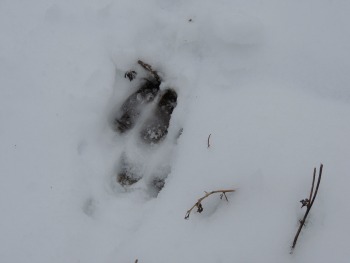Elk Tracks on a Beaver Dam
By Gary Lewis

Blackpowder hunts to plan for in Northwest Oregon
“I go out with a lawn chair and a Thermos full of soup and a sandwich. I leave the lawn chair so I don’t have to carry it the next day.” Jeff Strickland is the owner of TransAction in Forest Grove, a transmission repair shop,
In 1973, his parents gave him a muzzleloader and he has been burning blackpowder ever since. In fact, the day I met him, he had a muzzleloader in his hand, shooting targets on a woods walk at a rendezvous on Mount Hood.
Since the late 1980s, he has taken a few elk himself, with at least as much success as the statewide average, and he has guided half a dozen hunters to their first elk.
Late in the year, when there is snow in elk country and fog in the mountain valleys, those are the days he likes best. From his home near Forest Grove, he doesn’t have to go far to find elk country.
“I like to get in early on a closed road and try to get an hour plus away from the rig,” Strickland said.
 On the morning before Christmas one season, he carried a Thompson/Center 50-caliber Renegade that he built from a kit. He’d closed the shop for the day and was all by himself. Down in a canyon, in patchy snow, he found the track of a single elk where it crossed at a beaver dam.
On the morning before Christmas one season, he carried a Thompson/Center 50-caliber Renegade that he built from a kit. He’d closed the shop for the day and was all by himself. Down in a canyon, in patchy snow, he found the track of a single elk where it crossed at a beaver dam.
With his breath turning to cloud in the frosty air, he looked to his priming, checked that a cap was seated beneath the hammer, and began to work out the trail.
The prints showed plain in patches of snow and were harder to find out in the open where the sun had melted through. But the general trend of the animal’s path became clear as he looked ahead. The animal had moved away from the water and was headed up the slope – a cow, perhaps with another cow or a calf in tow – that had separated from the larger herd.
Strickland moved deliberate, but he moved fast. It’s not easy to catch up to an elk, but it can be done. He didn’t worry about stealth, but he hoped to catch a glimpse of the animal before it saw him.
Forty-five minutes after he cut the first track, Strickland caught a glimmer of tan and chocolate in the cedar trees. When the animal moved clear of a small fir tree, he eared back the hammer to full cock and put the front sight in the pocket behind the foreleg. He clicked the set trigger and touched off, all in one fast, fluid motion.
The rifle pushed against his shoulder and a blanket of white smoke lay between him and his quarry.
A week later, after the soreness in his muscles from a long pack-out had subsided, Strickland brought his son back to walk the same creek bottom. They found tracks at the beaver dam again, and took a second elk not far from where the first had come to rest.
Two hunts offer muzzleloaders good odds of bagging a tag in the Northwest corner of the state. The NW Cascades hunt (200M1) was undersubscribed last year, which meant every first chance applicant should have drawn a tag. This hunt takes in all of the Santiam and McKenzie units and part of the Indigo Unit. Hunters may take any elk outside of USFS lands and inside USFS lands, the bag limit is one bull. At seven days in November, the season isn’t long, but it’s longer than some centerfire hunts.
For a longer season, the NE Trask (214M) is one to consider. Here, the season runs for the last two weeks of December, but access is limited by public land. With three times as many people applying as there are tags, this one is not as easy to draw, but there are good numbers and the bag limit is one elk.
One of the best strategies, once a herd is located and patterned, is to sit in one good spot. Perhaps in a feeding area. Perhaps along an escape route where elk go when hunters move them.
Jeff Strickland would remind us, there are no secret spots. “There are just places elk go. You have to be out there.” Maybe even in a lawn chair.


